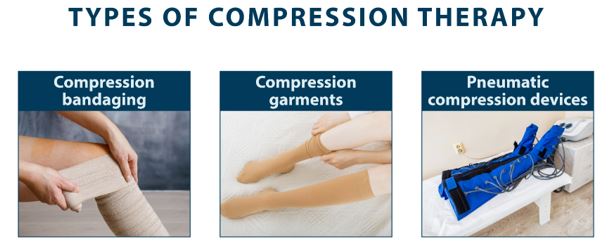Benefits of Compression Therapy
Compression therapy is a popular treatment method that offers numerous benefits for individuals dealing with various medical conditions. In this article, we will explore the advantages of compression therapy and how it can positively impact your health and well-being.
Improved Circulation
One of the key benefits of compression therapy is its ability to improve blood circulation. By applying gentle pressure to specific areas of the body, compression garments help promote the flow of blood back towards the heart. This can be particularly beneficial for individuals with conditions such as varicose veins, deep vein thrombosis, or lymphedema. Improved circulation can reduce swelling, prevent blood clots, and facilitate the healing process.
Reduced Swelling and Inflammation
Compression therapy plays a crucial role in reducing swelling and inflammation. The compression garments exert pressure on the affected area, which helps to prevent the buildup of excess fluid. By minimizing swelling, compression therapy can enhance comfort and mobility, allowing individuals to engage in their daily activities with ease. Moreover, it can aid in the recovery process after surgery or injury.
Enhanced Sports Performance and Recovery
Athletes and fitness enthusiasts often turn to compression therapy to improve their sports performance and aid in post-workout recovery. Compression garments provide targeted support to muscles and joints, reducing muscle fatigue and soreness. This can lead to enhanced endurance, increased power, and improved overall performance. Additionally, compression therapy helps to remove metabolic waste products from muscles, facilitating faster recovery and reducing the risk of injuries.
Prevention of Deep Vein Thrombosis
Deep Vein Thrombosis (DVT) is a serious condition that occurs when blood clots form in deep veins, typically in the legs. Compression therapy can be an effective preventive measure against DVT, especially for individuals who are at a higher risk, such as those who have undergone surgery or have limited mobility. By improving blood flow and preventing blood clots, compression therapy significantly reduces the likelihood of developing DVT.
Alleviation of Leg Discomfort
Compression therapy is widely used to alleviate leg discomfort caused by various conditions, including venous insufficiency, varicose veins, and edema. The compression garments exert pressure on the legs, helping to improve blood flow and reduce pain, achiness, and heaviness. This can greatly enhance the quality of life for individuals who experience chronic leg discomfort.

Compression therapy offers a wide range of benefits, including improved circulation, reduced swelling and inflammation, enhanced sports performance and recovery, prevention of deep vein thrombosis, and alleviation of leg discomfort. Whether you are dealing with a specific medical condition or simply looking to optimize your overall well-being, compression therapy can be a valuable addition to your healthcare routine. Consult with a healthcare professional to determine the most suitable compression garments for your needs and experience the positive impact of compression therapy firsthand.
Frequently Asked Questions about the Benefits of Compression Therapy
1. What is compression therapy?
Compression therapy involves the use of specially designed garments or devices to apply pressure to specific areas of the body. It helps improve blood circulation and can be used to treat various conditions such as lymphedema, varicose veins, and deep vein thrombosis (DVT).
2. How does compression therapy benefit individuals with lymphedema?
Compression therapy helps reduce swelling and improves the flow of lymphatic fluid, which is essential for managing lymphedema. It also helps prevent the progression of the condition and provides relief from symptoms like pain and discomfort.
3. Can compression therapy help with venous insufficiency?
Absolutely! Compression therapy is highly effective in managing venous insufficiency. It helps improve venous blood flow, reduces leg swelling, and alleviates symptoms like leg pain, heaviness, and fatigue.
4. Are there any benefits of compression therapy for athletes?
Yes, compression therapy can be beneficial for athletes. It helps enhance circulation, reduces muscle soreness, and aids in muscle recovery after intense workouts or competitions. It also provides support to the muscles, reducing the risk of injury.
5. Can compression therapy be used during pregnancy?
Yes, compression therapy can be used during pregnancy to alleviate symptoms of swollen feet and legs. It improves circulation, reduces swelling, and provides support to the legs, offering relief to pregnant women.
6. Does compression therapy help in preventing blood clots?
Compression therapy is often recommended to prevent blood clots, especially in individuals who are at a higher risk, such as those who have recently undergone surgery or have limited mobility. It helps improve blood flow and reduces the chances of clot formation.
7. Are there any benefits of compression therapy for individuals with varicose veins?
Yes, compression therapy is a commonly used treatment for varicose veins. It helps alleviate symptoms like pain, swelling, and heaviness in the legs. Regular use of compression stockings can also prevent the progression of varicose veins.
8. Can compression therapy be used for diabetic foot ulcers?
Compression therapy is often included in the treatment plan for diabetic foot ulcers. It helps improve blood flow to the affected area, promotes healing, and reduces the risk of infection. However, it should be used under the guidance of a healthcare professional.
9. Are there any side effects of compression therapy?
When used correctly, compression therapy is generally safe. However, some individuals may experience skin irritation, discomfort, or difficulty in wearing compression garments. It is important to consult a healthcare professional for proper fitting and guidance.
10. How long should compression therapy be used for optimal benefits?
The duration of compression therapy varies depending on the condition being treated. It can range from a few weeks to several months or even lifelong use in certain cases. It is best to follow the guidance of a healthcare professional to determine the appropriate duration of therapy.




